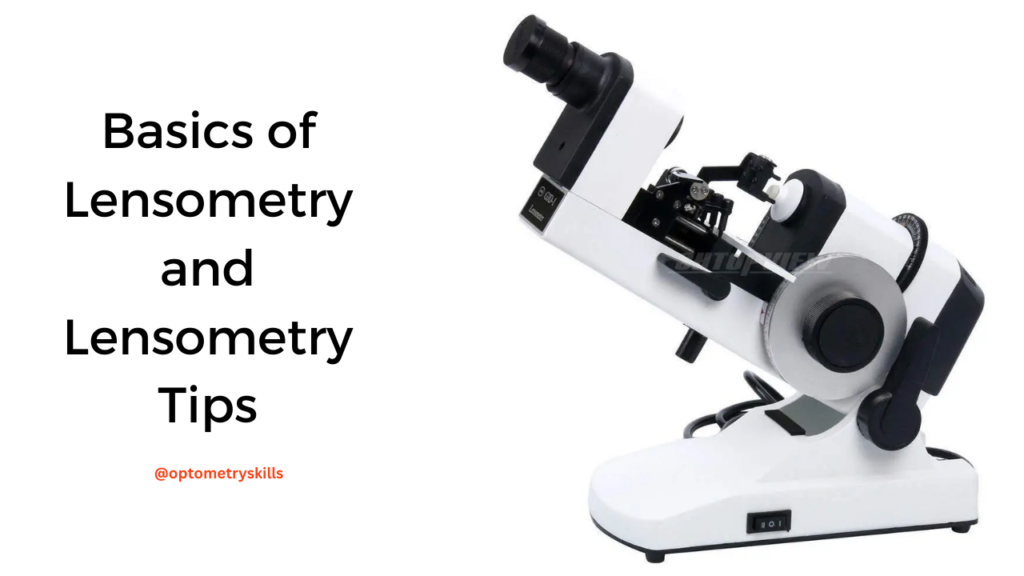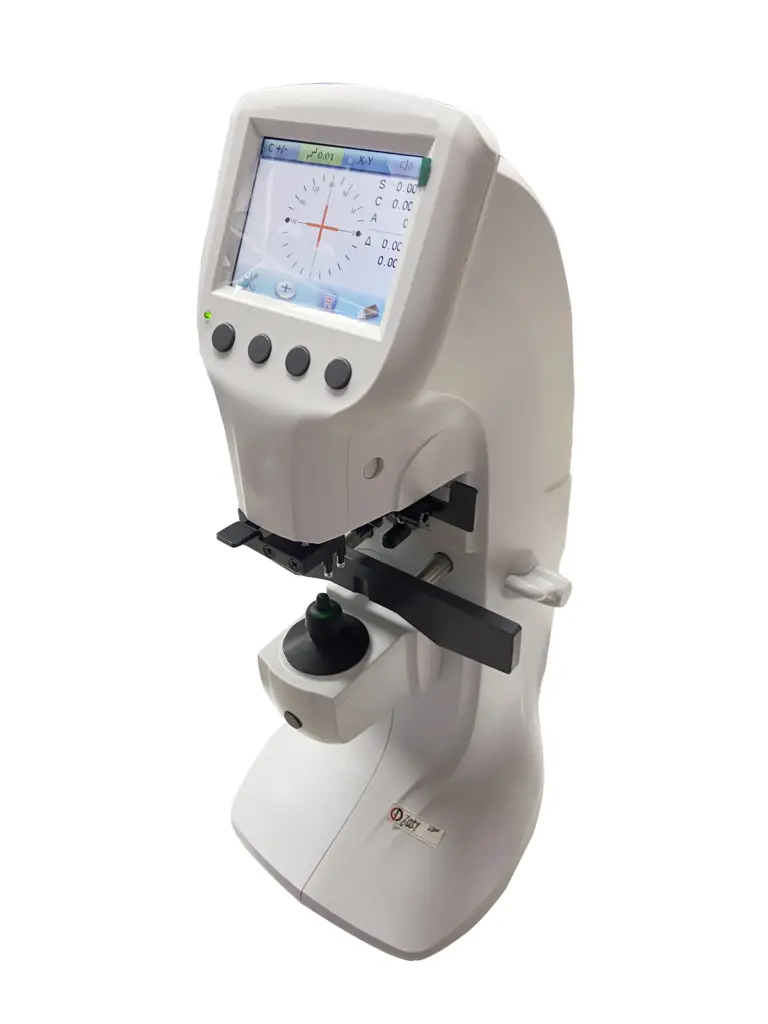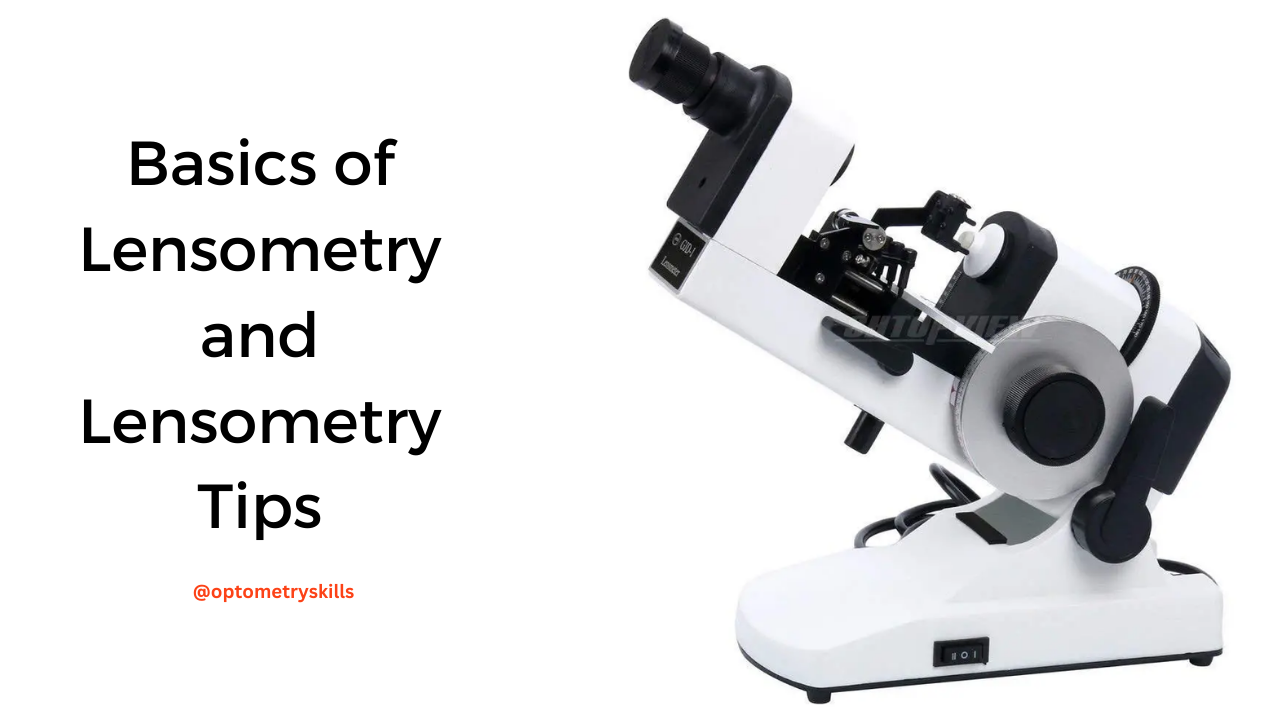Basics of Lensometry and Lensometry Tips
Lensometry, an indispensable component of optometry, plays a pivotal role in ensuring optimal vision correction.
A lensometer is a device used to measure various characteristics of lenses, including vergence and prism power. When a patient brings in a pair of eyeglasses without knowing the prescription, a lensometer becomes a valuable tool for determining key parameters in each lens, such as sphere power, cylinder power, axis, and the presence of prism. Additionally, it can be employed to identify the addition power (ADD) in multifocal lenses, such as bifocals, providing comprehensive information about the lenses’ specifications.
A. What Is Lensometry?
Lensometry, often referred to as lens analysis or lens power measurement, is a precise optical technique used to determine the characteristics of optical lenses. This encompasses deciphering lens power, axis, and prism correction, crucial for crafting accurate eyeglass prescriptions.
Definition and Concept
Lensometry involves quantifying the optical properties of lenses, enabling optometrists to prescribe corrective eyewear with unparalleled accuracy. By examining lenses, optometrists can assess and address various vision-related issues, ensuring patients receive the right eyeglass prescriptions.
Historical Background
The roots of lensometry trace back to the early 18th century when scientists and opticians began developing tools to measure and understand the properties of lenses. This innovation revolutionized the field of optometry, paving the way for precise vision correction.
Lensometry holds a central position in the practice of optometry, contributing significantly to eye exams and vision correction.
B. Types of Lenses
Lenses come in a diverse array of types, each serving a distinct purpose in vision correction. To comprehend lensometry fully, one must acquaint themselves with the primary categories of lenses.
Spherical Lenses
Spherical lenses are the simplest form of optical lenses, characterized by their curved surfaces. They correct common refractive errors like myopia (nearsightedness) and hyperopia (farsightedness).
Cylindrical Lenses
Cylindrical lenses, also known as toric lenses, address astigmatism. They possess distinct curvatures in different meridians and require specialized measurement techniques.
Compound Lenses
Compound lenses, as the name suggests, combine spherical and cylindrical elements. Accurate measurement is essential to determine both sphere and cylinder powers for precise prescription crafting.
Prism Lenses
Prism lenses are designed to alter the direction of light entering the eye, primarily used in cases of binocular vision disorders. Accurate measurement of prism power and orientation is critical for effective correction.

II. Tools and Equipment
A. Lensometer
The lensometer, a fundamental tool in lensometry, plays a pivotal role in measuring lens power and assessing lens characteristics.
A lensometer typically comprises an optical system, target screen, and a power scale. By aligning the lens under examination with the target screen, the optometrist can determine its power and axis.
How a Lensometer Works
To measure lens power, the lensometer projects a focused image of the lens onto the target screen. By manipulating the instrument’s controls, the optometrist aligns the lens image and evaluates the power reading.


2 types of Lensometer-Difference between them
Manual and automatic (or digital) lensometers are the two primary types of lensometers available. Here, we’ll explore the key differences between these two types of devices:
1. Operation:
- Manual Lensometer require the user to manually adjust various components to measure the lens prescription accurately. This involves manually aligning the lens, focusing the target lines, and making the necessary adjustments to read the prescription.
- Automatic or digital lensometers are electronically controlled and automated. They use digital displays and motorized components to measure and display the prescription values. The process is faster and often more user-friendly.
2. Speed:
- Manual ones require more time and effort to measure a lens accurately. The operator must take care to align and focus manually, which can be a slower process.
- Automatic ones are significantly faster. They can quickly provide precise measurements, making them a time-saving option in a busy eyecare practice.
3. Accuracy:
- Manual ones provide accurate measurements when used correctly. However, the accuracy relies on the operator’s skill in aligning and focusing the lens properly.
- Automatic ones offer consistent and precise measurements. They are less dependent on the operator’s skill, reducing the margin of error.
4. Ease of Use:
- Manual Lensometer: require training and practice to use effectively. Novice users may find them less intuitive.
- Automatic Lensometer are generally more user-friendly and require less training. The automated processes make them accessible to a broader range of users.
5. Features and Functions:
- Manual Lensometer typically have basic functionality, including measuring sphere, cylinder, axis, and prism. They may lack additional features found in automatic models.
- Automatic Lensometer often come with advanced features, such as data storage, connectivity options, and the ability to measure progressive and multifocal lenses. They offer more versatility in a modern eyecare practice.
6. Cost:
- Manual Lensometer are generally more affordable, making them a practical choice for smaller or budget-conscious practices.
- Automatic Lensometer are more expensive due to their advanced technology and features. They are a significant investment for larger and more high-tech practices.
7. Maintenance:
- Manual Lensometer typically require less maintenance as they have fewer electronic components. Regular calibration and occasional servicing are usually sufficient.
- Automatic Lensometer may require more maintenance due to their electronic components. Regular calibration and software updates may be necessary to ensure accuracy.

Steps to Neutralize Spectacle Power in a Manual Lensometer
Spectacle power neutralization is a fundamental skill for optometrists and eyecare professionals. This process involves determining the existing prescription in a pair of eyeglasses, which is crucial for providing accurate vision correction. A manual lensometer is the go-to tool for this task, allowing professionals to measure sphere power, cylinder power, axis, and prism present in each lens. Below, we’ll explore the step-by-step process to neutralize spectacle power using a manual lensometer.
Step 1: Prepare
Before you begin, ensure that the lensometer is properly calibrated and aligned. It’s essential to start with a well-functioning instrument for accurate measurements.
Step 2: Position
Place the eyeglasses with the lenses you want to neutralize on the lensometer’s stage. Make sure the lenses are securely held in place.
Step 3: Adjust the Target
Next, adjust the target screen of the lensometer so that it is sharp and clear. This screen is where you will observe the lens’s power and other parameters.
Step 4: Determine the Sphere Power
To neutralize the sphere power, first, focus on one lens (usually the right lens) while keeping the other lens blocked with the lensometer’s occluder. Rotate the lens until the sphere lines on the target are clear and aligned. The diopter scale on the lensometer will display the sphere power.
Step 5: Measure Cylinder Power and Axis
Now, focus on the cylinder power and axis. Remove the occluder and turn the lensometer’s axis wheel until the cylinder lines are sharp. Note the cylinder power and read the axis value from the axis scale on the lensometer.
Step 6: Identify Prism
To detect any prism present in the lens, observe the crosshair lines on the lensometer’s target. If the lines shift horizontally or vertically, it indicates the presence of prism. The amount and direction of prism can be determined by the degree and direction of shift.
Step 7: Neutralize the Left Lens
Repeat steps 4 to 6 for the left lens to determine its sphere power, cylinder power, axis, and prism (if present).
Step 8: Calculate the Total Prescription
Now that you have determined the powers and other parameters for both lenses, you can calculate the total prescription for the eyeglasses. Add the sphere power of the right and left lenses together. If there is a cylinder component, calculate the combined cylinder power and record the axis for the right and left lenses. If prism is present, take note of the prism power and direction for both lenses.
Step 9: Verify Accuracy
It’s crucial to double-check your calculations and measurements to ensure accuracy. Any errors could result in an incorrect prescription, leading to vision problems for the patient.
Step 10: Record the Prescription
Finally, record the determined prescription, including sphere power, cylinder power, axis, and prism (if present). This prescription can then be used for ordering new eyeglasses or making adjustments to the existing ones.
B. Lensmeter vs. Lensometer
It’s imperative to distinguish between the terms “lensometer” and “lensmeter,” as they are often used interchangeably but refer to distinct tools.
While both instruments measure lens power, a lensometer is typically used for manual lens measurements, whereas a lensmeter often encompasses automated features, enhancing efficiency and accuracy.
Common Lensometry Terminology
A. Diopters and Lens Power
Diopters, denoted by the symbol “D,” are a fundamental unit of measurement in lensometry.
Understanding Diopters
Diopters represent the refractive power of a lens. A positive diopter value indicates convergence, typically for correcting farsightedness, while negative diopter values signify divergence, used to address nearsightedness.
Conversion of Lens Power
Lensometry often involves converting lens power between different formats, such as from plus to minus or vice versa. Accurate conversions are essential for prescription adjustments and patient comfort.
B. Vertex Distance
The distance between the lens and the patient’s eye, known as vertex distance, influences lens power.
Impact on Lens Power
Changes in vertex distance can alter the effective lens power perceived by the patient. Understanding this phenomenon is critical for ensuring accurate prescription fulfillment.
Practical Considerations
In clinical practice, optometrists must consider the vertex distance when prescribing lenses to guarantee optimal vision correction and patient satisfaction.
B. Lensometry Challenges
Despite its importance, lensometry presents challenges that require expertise to overcome.
Common Pitfalls
Understanding and addressing common pitfalls, such as misalignment or calibration issues, is essential to maintain the accuracy of lensometry instruments.
Troubleshooting Tips
Professionals must be adept at troubleshooting any discrepancies in lensometry measurements, ensuring patients receive optimal visual correction and comfort.
X. Practical Lensometry Tips
A. Proper Usage
Proficiency in lensometer operation is paramount for accurate measurements.
Step-by-Step Guidelines
Following systematic procedures, including calibration, alignment, and measurement, ensures precise and consistent results.
Best Practices
Adhering to best practices in lensometer usage enhances efficiency and reduces the likelihood of errors, benefiting both the optometrist and the patient.
B. Maintenance and Calibration
The upkeep of lensometry equipment is crucial to its reliability.
Keeping the Lensometer Accurate
Regular maintenance and calibration procedures prevent instrument drift and ensure consistent, accurate measurements.
Routine Maintenance Tips
Practical tips for maintaining lensometry equipment, such as cleaning lenses and verifying alignment, prolong their lifespan and performance.
Advances in Lensometry
A. Digital Lensometry
The advent of digital technology has brought significant advancements to lensometry.
Introduction to Digital Tools
Digital lensometers offer automation and precision, streamlining the measurement process and reducing human error.
Benefits and Limitations
Exploring the advantages and limitations of digital lensometry allows optometrists to make informed decisions about incorporating these tools into their practice.
B. Automation and AI
Artificial intelligence (AI) is transforming the field of lensometry.
AI-Assisted Lensometry
AI-driven lensometry tools assist optometrists in making highly accurate measurements, enhancing patient outcomes.
Future Trends
The integration of AI in lensometry is likely to continue evolving, offering even more sophisticated diagnostic and measurement capabilities.
Buy Lensometer online
JD-2600A 7” LCD Touch Screen New Digital Auto Lensmeter Lensometer Focimeter

Buy from Amazon
Hope you enjoyed our quick lensometry training 🙂
Read : Being an optometrist- the optometry blog
Follow us in Facebook
